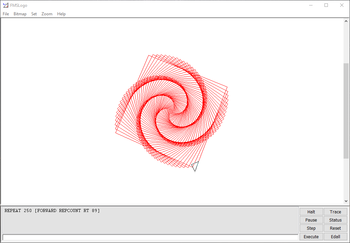FMS logo
| FMS logo
|
|
|---|---|

|
|
 Screenshot of FMSLogo v6.35.0 |
|
| Basic data
|
|
| Maintainer | David Costanzo |
| Publishing year | 2005 (1992) |
| Current version | 7.3.0 (November 24, 2018) |
| operating system | Windows NT |
| License | GNU General Public License |
| German speaking | Yes |
| http://fmslogo.sourceforge.net/ | |
FMSLogo is an integrated development environment and free implementation of the education-oriented programming language Logo and is mainly used for school purposes. Originally, FMSLogo was developed under the name MSWLogo by George Mills, who implemented a user interface and extensions to Brian Harvey's UCBLogo. Due to the change of the developer to David Costanzo, the software was renamed and from then on he expanded and improved it. The source code, written in Borland C ++ and WxWidgets , is licensed under the GNU General Public License .
distribution
FMSLogo has been downloaded over 300,000 times via the official project page on SourceForge since its publication in 2005, including almost 15,000 downloads from Germany (as of November 2018).
Version 6.5b of its predecessor, the MSWLogo, has had over 1.1 million downloads on the Softonic software portal since it was published there in 2008 and achieved an average of 16,500 downloads per month.
history
Beginnings
In July 1992, the first version of George Mills for MS-DOS and Windows 3.X was released. It was a port of an already existing project called DOSLOGO. It supported the most basic logo commands for controlling the turtle, as well as some graphics commands, such as setting a background color.
Just a month later, he released version 2.0. The graphical user interface has been expanded and received the buttons for stopping execution or switching to the editor, which are still available in today's version. Shortly afterwards, the generated graphics could also be saved and loaded as a bitmap image.
UCBLogo as a basis
Version 3.0, published on December 7, 1992, was based for the first time on the UCB logo developed by Brian Harvey. B. Limitations on recursions could be lifted, there was a better error output and the logo syntax was adapted to the standard specified by UCBLogo. This version is a combination of the extensions and the graphical user interface of the previous versions and the UCBLogo core.
Control elements, event-oriented programming and control of external hardware
In version 3.3, controls such as windows, dialog boxes, check boxes and combo boxes have been implemented. Also, now is event-driven programming via mouse and keyboard possible. Furthermore, robots could now be controlled via ports. With the next version tones could be generated and MIDI devices could be controlled.
32-bit version and several turtles
With version 4, a 32-bit version for Windows 95 was published for the first time in addition to the 16-bit version . From now on 1024 independent turtles can be created to which a bitmap image can now be assigned.
Networking
Networking via TCP / IP is supported from version 5.0 . This feature makes it possible to control other MSWLogo instances over the Internet.
3D mode
MSWLogo 6.0 was released in 1997. With this version, the development environment was given a 3D mode and the associated commands were added.
Change of developer and renaming
On December 19, 2002, the last MSWLogo version 6.5b, developed by Mills, was released. In 2005, the developer and supervisor of a computer club, David Costanzo, reported on a forum post and announced that new versions would be available on the Sourceforge software portal under the name FMSLogo, as the name MSWLogo is protected by copyright . On October 11th he published FMSLogo 6.6.
Since 2005, 42 versions of the FMSLogo have been published. As of version 7, Windows 9X and screens with less than 16-bit colors are no longer supported; the logo was also replaced.
Features
FMSLogo supports various functions:
- "Standard" logo parsing
- Turtle graphic
- Error messages
- TCP / IP networking
- Text in all available fonts
- 1024 independent turtles
- "Bitmap Turtles"
- MIDI devices
- direct I / O for controlling external hardware
- Serial and parallel port communication
- Saving and loading images
- Calling DLLs
- Creation of dialog boxes
- event-oriented programming (mouse, keyboard, timer)
- Control of multimedia devices (WAV files, CD-ROM etc.)
- 3D perspective drawing
- Creation of animated GIF images
Individual evidence
- ↑ Download Statistics: All Files. In: sourceforge.net. Retrieved January 9, 2016 .
- ^ MSW logo. In: Softonic. Retrieved January 9, 2016 .
- ↑ Google Groups. In: groups.google.com. Retrieved January 8, 2016 .
- ↑ Google Groups. In: groups.google.com. Retrieved January 9, 2016 .
- ↑ Google Groups. In: groups.google.com. Retrieved January 9, 2016 .
- ↑ Google Groups. In: groups.google.com. Retrieved January 9, 2016 .
- ↑ Google Groups. In: groups.google.com. Retrieved January 9, 2016 .
- ↑ Google Groups. In: groups.google.com. Retrieved January 9, 2016 .
- ↑ Google Groups. In: groups.google.com. Retrieved January 9, 2016 .
- ^ MSW Logo, An Educational Programming Language. In: www.softronix.com. Retrieved January 9, 2016 .
- ↑ Google Groups. In: groups.google.com. Retrieved January 9, 2016 .
- ↑ Google Groups. In: groups.google.com. Retrieved January 9, 2016 .
- ↑ FMSLogo - Browse / FMSLogo at SourceForge.net. In: sourceforge.net. Retrieved January 9, 2016 .
- ↑ Home - FMSLogo. In: fmslogo.sourceforge.net. Retrieved January 9, 2016 .
Further web links
- FMSLogo ZSF lecture (PDF) on the education server of the State of Rhineland-Palatinate
- Welcome to the Logolei , blog with application examples in FMSLogo